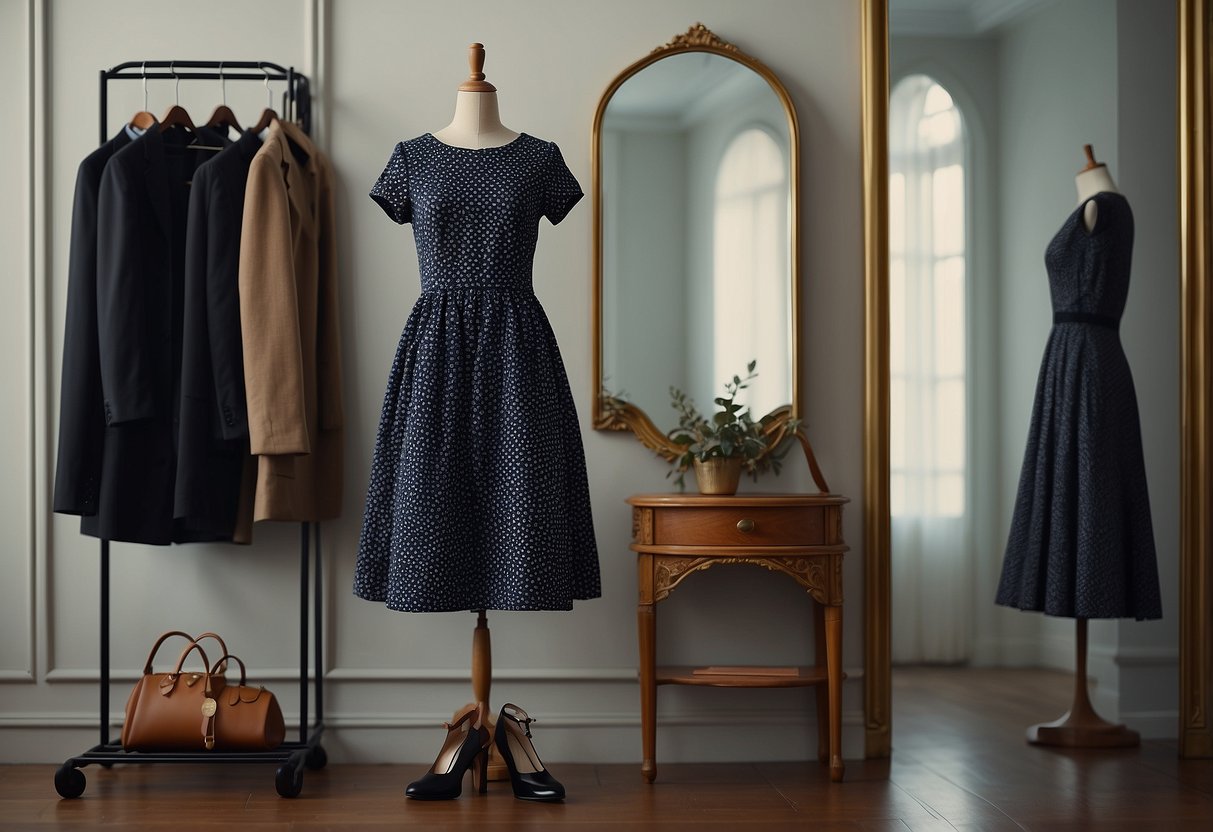
Color and Pattern Play
Color and patterns can dramatically affect the harmony between vintage and modern fashion. Understanding how to pair them allows for a unique and cohesive look.
Pairing Color for Visual Interest
Colors can set the tone for your outfit. Mixing vintage and modern pieces calls for attention to color harmony. Select a primary color as the base and complement it with accents. For instance, a vintage mustard blouse pairs well with modern navy pants.
Contrasting colors, like pairing a retro red polka dot skirt with a contemporary white top, can make your outfit pop without clashing. Neutral tones such as beige, black, or white can balance bolder colors. The blend of bright and muted tones ensures a cohesive yet striking appearance.
Mixing Patterns Intelligently
Patterns add dimension to your outfit, but balancing them can be challenging. Start with smaller patterns like polka dots paired with larger prints. For example, a vintage polka dot blouse matches well with modern geometric print pants.
Stick to similar color families to avoid visual chaos. Mixing a vintage floral pattern with a modern stripe works best when they share similar hues. Limit the number of patterns to two or three, keeping one as the dominant motif and others as accents.
Harmonize patterns by ensuring one pattern is subtler than the other. A delicate vintage lace top can pair with a bold modern print skirt, offering a balanced and intriguing look.
The Art of Layering for Contrast
Layering vintage and modern fashion pieces can create a striking and unique look. To master this art, it’s crucial to focus on harmonizing different textures and fabrics, as well as building depth through various layers.
Texture and Fabric Combinations
Combining textures is key to achieving a visually interesting outfit. Heavier fabrics such as wool, tweed, or corduroy from vintage pieces work well with lighter modern materials like silk, satin, or mesh. This contrast not only adds visual interest but also provides a tactile dimension. Textures can make an outfit look rich and multi-dimensional.
Mixing fabrics like lace with leather or denim with velvet creates a balanced yet eclectic look. Choose colors that complement each other to prevent the outfit from looking chaotic. For example, pairing a rugged denim jacket with a delicate lace blouse can add a fresh twist to both garments. In colder months, incorporating chunky knits over sleek dresses offers both style and warmth.
Creating Depth with Layers
Layering not only enhances the aesthetic but also adds functional aspects like warmth and versatility. Start with a basic top such as a fitted turtleneck or a crisp shirt, then add a mid-layer like a vest or a lightweight jacket. Finish with a statement piece, perhaps a vintage coat or a fashionable blazer.
For depth, play with lengths and silhouettes. A long trench coat over a short dress adds length and drama, while a cropped jacket over a maxi dress can redefine proportions. Multiple layers of varying lengths create a sense of depth and movement, making the outfit more dynamic. Accessories such as scarves, belts, and hats can also contribute to the layered look, enhancing the overall depth and richness of the ensemble.
By focusing on these elements, one can artfully merge vintage and modern pieces to create unique, layered outfits that stand out.
Dressing for the Occasion
When integrating vintage and modern fashion, it is essential to dress appropriately for different occasions. Dressing for casual settings requires different elements compared to formal events or professional environments.
From Casual to Formal
Blending vintage with modern for casual outings can be both chic and practical. A pair of vintage jeans paired with a contemporary top creates a comfortable yet stylish look. Accessories like retro sunglasses or a classic leather watch can add a subtle vintage touch.
For formal events, vintage dresses or suits can stand out. A 1950s cocktail dress with modern heels can be a stunning choice. Pairing a vintage blazer with modern tailored trousers can provide a sophisticated appearance. The key is to balance old and new elements to create a cohesive look.
Vintage for Professional Settings
In professional settings, incorporating vintage pieces can showcase individuality without compromising professionalism. Vintage blouses or skirts can be paired with modern blazers or trousers. This combination maintains a polished appearance while adding unique flair.
For men, vintage ties or cufflinks can complement a modern suit. Vintage briefcases or bags can also be both functional and stylish. When selecting vintage items for the office, it’s important to choose pieces that enhance the professional look rather than overpower it. Careful integration of vintage elements can make a strong, stylish statement.



